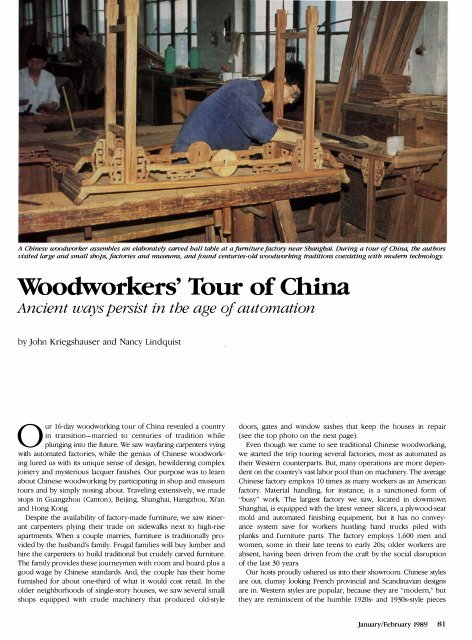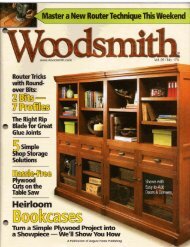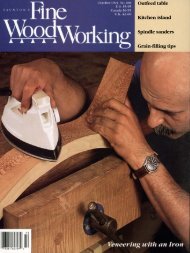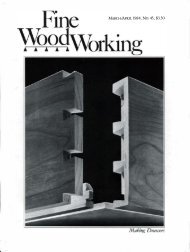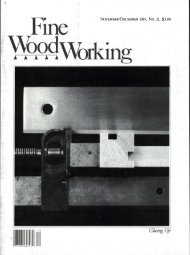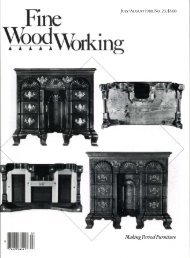often they're not, these depressions are advertisements for aburied treasure.If you're in the woods looking for bird's-eye maples, checkalong hollows and gullies or on the northwest slopes of hills.These are areas where young trees have to tough it out, and consequently,are ideal environments fo r bird's-eye fo rmation. It alsohelps to know if bird's-eye maples are apt to grow in your region.In southern Wisconsin, which is not prime bird's-eye maple country,foresters say you might find one tree out of 10,000 with goodbird's-eye figure. But loggers say that 300 miles north, in Michigan'supper peninsula-bird's-eye maple heaven-you'll find approximatelyone maple in 400 with the figure.Characteristics-Structurally, bird's-eye maple isn't much differentfrom normal hard maple. Because figured maples grow slower,you might expect the wood to be a bit denser. Air-dried bird's-eyemaple weighs 47 Ibs. per cubic foot and has a specific gravity of.68, a bit higher than the .63 fo r normal air-dried maple.Bird's-eye maple is a hard, tough wood. It has a uniform texture,glues well and takes a good finish. Its creamy white wood is oftenstreaked amber to brown, usually the result of defects or diseasein the tree. Technologists at the Forest Products Laboratory saygrain deviation in mildly figured bird's-eye maple won't affectstrength, but they caution that highly figured wood won't be asstrong as straight-grained wood fo r spindle support members,such as chair legs.Bird's-eye maple seasons slowly, and because of its wild grain,has a higher shrinkage factor than ordinary hard maple. This cancause buckling as it dries. In fact, careful drying of the wood iscritical. Air-drying or the use of a solar kiln with a slow dryingschedule are best. Rapidly kiln-dried bird's-eye maple can result intwisted lumber with eyes eager to chip out. Hairline cracks aroundthe eyes are a sure sign the wood has been dried improperly. Becauseof the way the eyes grow, most bird's-eye lumber is plainsawnto reveal the full figure; if quartersawn, the figure will be masked.Prices for bird's-eye lumber vary widely depending on meamount of figure. Strangely enough, through a quirk in the NationalHardwood Association's rules, bird's-eyes, like so many knots, arecounted as defects. Consequendy, bird's-eye maple that's not sortedfor specialty markets at the sawmill may be graded low. This, nodoubt, accounts for a lot of 2-in.-wide bird's-eye maple strips I'veseen ignominiously gracing gymnaSium floors. Fortunately, loggersare a pretty shrewd bunch: Before maple logs are run through thesawmill, the obvious bird's-eye logs are sorted out. Good bird'seyecan bring a sharp-eyed logger an extra $100 per 1,000 bd. ft.European veneer buyers also have a warm spot for bird's-eyelogs. According to one veneer exporter, the Europeans have theirown grading system for bird's-eye veneer logs. He says they lookfor white wood, large eyes and a lot of curl. They examine a log byscooping out small portions of wood with a knife and by checkingfor the spoke-like pattern of bird's-eye on the ends of a log. Mostwoodworkers, however, aren't so particular: Some prefer bird'seyemaple that has rich streaks of brown in it, feeling that it givesthe wood more character.Working with bird's-eye- Despite my affection for bird's-eye maple,I use it sparingly. Because it's 0 "busy" visually, I think itrequires a well-developed design eye to make it work effectively.But with some thought, dlis extravagantly figured wood can transformnice work into special work. The deviating grain around theeyes gives the wood a chatoyant quality: It gathers light in ripples,providing a luster as changeable as that of a fire opal.The very qualities that make this wood so appealing to the eyealso make it a nightmare to work. The swirling grain is notoriousfor chipping out, so planing it can be an exasperating experience.The dense wood will burn on a belt sander if you aren't careful, somake sure your belts are reasonably new, and keep the work movingto avoid burn marks.I've had good luck using a hand scraper for finishing touches.Hone the scraper and then put a light burr on it by running aburnisher over the edge once or twice. Use a shallow angle, andpull the scraper lightly across the wood's surface.To find out how others approach the surly stuff, I talked to somewoodworkers who use bird's-eye maple regularly. Some of them,especially the ones that require precise dimensions for jOinery,don't like to mess with thicknessing it themselves. They prefer tobuy it to thickness or glue it up and take it to someone who has aheavy-duty thicknessing sander. The dollars spent, they claim, arewell worth the time saved and the avoided aggravation.Those who do plane it themselves use varying techniques seasonedwith a lot of common sense. Planing only the side of theboard closest to the pith is a logical approach to bringing it to thedesired thickness (the other side is just thickness-sanded). Becausebird's-eye grows as a series of cones pointing toward the tree'spith, the planer blades, in theory, slice off the protruding cones,leaving a smooth surface. Another woodworker takes a similar approachwith an added twist: He sharpens his planer blades andthen gives them a l(f back bevel. In effect, the blades act as scrapers,so he can't remove much-sometimes as little as Y64 in. on a pass,depending on the wood's figure. But, he ends up with a satinsmoothsurface on bird's-eye maple and other troublesomewoods, like quartersawn cherry.Machining bird's-eye wood on a jointer is straightforward, butcommon sense should prevail. Examine the grain to determinewhich way to run the plank through. A reliable method is to run yourthumb along the edge to feel the srubble of the opposing grain soyou can tell which direction is the path of least resistance and therebyminimize tearout. Make sure your blades are razor sharp, thenrun the wood through slowly, taking off Y32 in. or less on each pass.The cross forces exerted by the wild grain in bird's-eye woodprobably help to stabilize it. Once flat, bird's-eye lumber will generallystay dut way. However, like other woods, bird's-eye lumbercan cup if it dries unevenly. If you have the time, it's a good idea tolet it adjust to conditions in your shop after preliminary machining.After a couple of weeks, you can true it up.Bird's-eye maple turns nicely, and I haven't run into any problemswith chipping: I keep my gouges and scrapers sharp and usea light touch. The orientation of the bowl blank on the lathe is amatter of preference, not utility.Working with bird's-eye maple veneer isn't much different thanworking widl other veneers, but according to furniture designerDick Wickman of Verona, Wisc., bird's-eye veneer tends to crackalong parallel lines that can break dlroUgh the finish.Bird's-eye maple can be finished like most other woods, but here'show profeSSional woodfinisher Rob Ray of Madison, Wisc., finishesbird's-eye solid wood and veneer: First, he applies one coat of lacquer,diluted 3:1 with lacquer thinner, and allows it to dry. Thisfi lls the pinholes and makes loose fibers stand up. Then, he scuffsthe surface lightly with 320-grit sandpaper, being careful not tosand through the lacquer surface. Now he applies a color-matchedpaste wood filler, thinned with naptha. He let's this just barely dry,then wipes the surface with burlap and rags. He applies the surfacefinish of his choice, and completes the job by hand-rubbing. 0Bill Keenan, fOI-merly a forester, is now a writer, editor and woodworker.He lives in Madison, Wise.80 Fine Woodworking
A Chinese woodworker assembles an elaborately caroed hall table at a furniture factory near Shanghai. During a tour Of China, the authorsvisited large and small shops, factories and museums, and found centuries-old woodworking traditions coexisting with modern technology.Woodworkers' Tour of CAncient ways persist in the age of automationhinaby John Kriegshauser and Nancy LindquistOur 16-day woodworking tour of China revealed a countryin transition-married to centuries of tradition whileplunging into the future. We saw wayfaring carpenters vyingwith automated factories, while the genius of Chinese woodworkinglured us with its unique sense of design, bewildering complexjoinery and mysterious lacquer finishes. Our purpose was to learnabout Chinese woodworking by participating in shop and museumtours and by simply nosing about. Traveling extensively, we madestops in Guangzhou (Canton), Beijing, Shanghai, Hangzhou, Xi'anand Hong Kong.Despite the availability of factory-made furniture, we saw itinerantcarpenters plying their trade on sidewalks next to high-riseapartments. When a couple marries, furniture is traditionally providedby the husband's family. Frugal families will buy lumber andhire the carpenters to build traditional but crudely carved furniture.The family provides these journeymen with room and board plus agood wage by Chinese standards. And, the couple has their homefurnished for about one-third of what it would cost retail. In theolder neighborhoods of Single-story houses, we saw several smallshops equipped with crude machinery that produced old-styledoors, gates and window sashes that keep the houses in repair(see the top photo on the next page).Even though we came to see traditional Chinese woodworking,we started the trip touring several factories, most as automated astheir Western counterparts. But, many operations are more dependenton the country's vast labor pool than on machinery. The averageChinese factory employs 10 times as many workers as an Americanfactory. Material handling, for instance, is a sanctioned form of"busy" work. The largest factory we saw, located in downtownShanghai, is equipped with the latest veneer slicers, a plywood-seatmold and automated finishing equipment, but it has no conveyancesystem save for workers hustling hand trucks piled withplanks and furniture parts. The factory employs 1,600 men andwomen, some in their late teens to early 20s; older workers areabsent, having been driven from the craft by the social disruptionof the last 30 years.Our hosts proudly ushered us into their showroom: Chinese stylesare out, clumsy looking French provincial and Scandinavian designsare in. Western styles are popular, because they are "modern," butthey are reminiscent of the humble 1920s- and 1930s-style piecesJanuary/February 1989 81
- Page 3 and 4:
FineW> rktng'_' ______ ___ January/
- Page 6 and 7:
Letters (contillued)never hurt hims
- Page 8 and 9:
MetiJods of Wo rkedited and drawn b
- Page 10 and 11:
Methods of Wo rk (contillued)exampl
- Page 12 and 13:
Making a door sandwichI intend to m
- Page 14 and 15:
Q & A (colltillued)of a bad situati
- Page 16 and 17:
Pollou'-upby Dick BurrowsMore on to
- Page 18 and 19:
Easy toStep by Step DrawingsBuildOn
- Page 20 and 21:
(25 years)P-SOO20" PlANERSEATTLE:1
- Page 22 and 23:
There areover 4,000money-savingreas
- Page 24 and 25:
READY TO ASSEMBLE-SOLID-CHERRYWALNU
- Page 26 and 27:
THE BARTLEYBUNDLES!AlJ.500 ·24"Ban
- Page 28 and 29:
A GREAT DEA.L IMORE (f)5 HP, 3 Ph3
- Page 30 and 31: --ANTIQUE & USED TOOLSQuality, olde
- Page 32 and 33: PhoneStater--- - -[][]Ur:iTheWoodwo
- Page 34 and 35: """""',' Universal Precision Measu
- Page 36 and 37: FineWorking January/February 1989M
- Page 38 and 39: Once the backrest plaques are joine
- Page 41 and 42: Fig. 4:.1:iim.lf1lmllli.iiiiie?tII
- Page 43 and 44: Secret compartments were so common
- Page 45 and 46: -----.JFig. 4: Hanging tray below t
- Page 47 and 48: Tbree examples of the author's slid
- Page 49 and 50: worked but will maintain a crisp, s
- Page 53 and 54: SCROLL-SA W TESTCompany and model L
- Page 55 and 56: An ordinary woodturning lathe can b
- Page 57 and 58: use a dust collector, and if possib
- Page 59 and 60: I've never been especially fond of
- Page 61 and 62: and it shields your fingers from ex
- Page 63 and 64: The cabinet scraper used by the aut
- Page 65 and 66: Fig. 2: Post:Modern Table Top, 52 i
- Page 67 and 68: Fig. 3: LFI TableNut is fastened to
- Page 69 and 70: Fig. 3: Curved miterPattern doesn't
- Page 71 and 72: Selections from the author's sketch
- Page 73 and 74: thor anticipate problems and make f
- Page 75 and 76: Fig. 2: Air flowMoist air exits thr
- Page 77 and 78: lating fan. The idea here is to ins
- Page 79: Long prized by woodworkers for its
- Page 83 and 84: Chinese shaping toolsThroughout Chi
- Page 85 and 86: Using a Holtzapffel ornamental lath
- Page 87 and 88: NOW! BUY BRIDGEWOOD IN CANADA . ..
- Page 89: QiUl j!! IIIc:Ul.=:c ...!!
- Page 92 and 93: 111,"11SIOPm'EI.I,lu it ....IS •
- Page 94 and 95: CARBIDE TIPPED ROUTER BITSPRCAL PRO
- Page 96: FS Tool CorporationP.o. Box 510, 21
- Page 99 and 100: ... !Ij*;::""' eMore NTS 14-5614" H
- Page 101 and 102: FI:\ISHI:\G SLPPLIESIf you have bee
- Page 103 and 104: T\UNTONPUBliCATIONS... by fellow en
- Page 105 and 106: PmeWqqQWorkingIndex to issues 66 th
- Page 107 and 108: FowlerFowler, Brian, chair by, 67,1
- Page 109 and 110: ScrewsZimmerScrews:brace driving of
- Page 111 and 112: 34-76 1 10' Uni s-l-l/2 hp ........
- Page 113 and 114: MOISTURE METERFAMOUS "MINI-LiGNO"MA
- Page 115 and 116: Dependable extra hands for all type
- Page 117 and 118: MIRRORA· THE HAND MIRRORCOMPLEMENT
- Page 119 and 120: £'Delrl.lnc'e To Manufacture Quali


